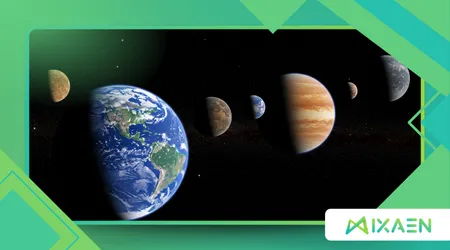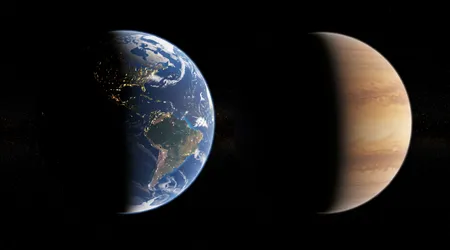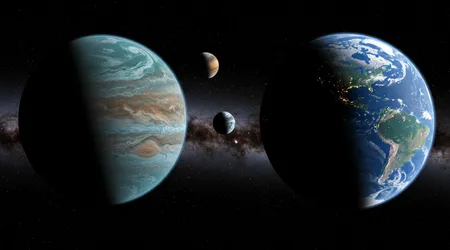How Ancient Earth May Resemble Life on Exoplanets Today

Ancient Earth May Resemble Life on Exoplanets Today, a concept that sparks curiosity about life’s origins and its potential across the cosmos.
Anúncios
The early Earth, a cauldron of chemical reactions and extreme conditions, offers a window into what life on distant exoplanets might look like today.
By studying our planet’s ancient past billions of years ago when simple microbes thrived in oxygen-scarce oceans we can hypothesize about extraterrestrial ecosystems.
This exploration bridges Earth’s history with the search for alien life, leveraging cutting-edge discoveries from telescopes like the James Webb Space Telescope (JWST).
As we probe exoplanets, from rocky worlds to ocean-covered sub-Neptunes, the parallels with Earth’s primordial state grow clearer. Why does this matter? It reshapes how we define habitability, pushing us to rethink what makes a planet a cradle for life.
The quest to understand life beyond Earth is no longer science fiction it’s a scientific frontier. Advances in spectroscopy and exoplanet detection have revealed thousands of worlds, some with conditions eerily similar to ancient Earth.
From methane-rich atmospheres to potential water oceans, these planets challenge our assumptions about where life can thrive.
This article dives into how Earth’s distant past mirrors conditions on exoplanets today, using real data and innovative science.
We’ll explore biosignatures, geological parallels, and the role of stellar environments, offering a fresh perspective on the cosmic search for life.
Earth’s Ancient Blueprint: A Template for Alien Worlds
Long before oxygen filled Earth’s skies, our planet was a harsh, alien world itself. Ancient Earth May Resemble Life on Exoplanets Today because its early conditions methane-heavy atmospheres, volcanic activity, and liquid water mirror what we observe on some exoplanets.
Around 3.5 billion years ago, Earth’s oceans hosted anaerobic microbes that used rhodopsins to harness sunlight, a process simpler than photosynthesis. These microbes thrived without oxygen, relying on chemical energy from volcanic vents.
This primordial setup offers clues about exoplanets like K2-18b, a sub-Neptune 124 light-years away. Recent JWST observations detected methane and carbon dioxide in its atmosphere, hinting at a possible water ocean.
++ Could Gas Giants Like Jupiter Hide Floating Ecosystems?
Such conditions echo Earth’s pre-oxygen era, when life was simple but resilient. Could K2-18b harbor similar microbial life? The question drives astrobiologists to study Earth’s ancient rocks for answers.
By reconstructing Earth’s early biosphere, scientists identify biosignatures chemical markers like methane that could signal life on exoplanets.
These markers are critical for interpreting data from distant worlds, where direct observation remains impossible. Earth’s past is a lens for decoding alien atmospheres, guiding our search for habitable planets.

Biosignatures: Echoes of Life Across the Stars
Detecting life on exoplanets hinges on biosignatures, molecules like oxygen or methane that suggest biological activity.
Ancient Earth May Resemble Life on Exoplanets Today because its early biosignatures align with those we seek on distant worlds.
For instance, dimethyl sulfide (DMS), produced by Earth’s marine phytoplankton, was tentatively detected on K2-18b in 2025, sparking excitement.
On Earth, DMS is a hallmark of microbial life, but its presence elsewhere demands caution non-biological processes could mimic it.
Consider TRAPPIST-1’s planets, seven Earth-sized worlds orbiting a red dwarf star. JWST data from 2025 showed no atmosphere on TRAPPIST-1d, but outer planets may retain water vapor or methane, reminiscent of Earth’s anaerobic past.
Also read: Are We Looking for Alien Life in the Wrong Way?
These findings suggest that life could exist in forms we barely understand, adapted to alien chemistries.
The challenge lies in distinguishing biotic from abiotic signals. Earth’s history teaches us that methane, abundant in its early atmosphere, was produced by microbes before oxygen dominated.
By studying ancient sediments, scientists refine models to spot similar signals on exoplanets, ensuring we don’t misinterpret geological noise as life.
Geological Parallels: Earth’s Past Meets Exoplanet Presents
Earth’s geological record holds secrets that resonate with exoplanet research. Ancient Earth May Resemble Life on Exoplanets Today through shared features like volcanic activity and plate tectonics, which shaped our planet’s habitability.
Early Earth’s volcanic outgassing created a methane-rich atmosphere, stabilizing liquid water despite a faint young Sun. Exoplanets like LHS 1140b, orbiting a stable red dwarf, may follow a similar path, with potential oceans sustained by geological processes.
Take the example of a hypothetical exoplanet, “Paleo-1,” orbiting a red dwarf 50 light-years away. Its volcanic activity could release methane, creating a greenhouse effect to support liquid water, much like Earth 3 billion years ago. This scenario, grounded in Earth’s history, guides astronomers in selecting exoplanets for study.
Read more: What If the First Alien We Find Is Just a Microbe?
The Silurian Hypothesis, proposed in 2018, asks if an advanced civilization could leave detectable traces in Earth’s geological record.
While speculative, it underscores how subtle signs like synthetic molecules or isotopic anomalies could reveal life on exoplanets, mirroring Earth’s ancient geological fingerprints.
Stellar Environments: Shaping Life’s Potential
A planet’s star dictates its habitability, just as our Sun shaped early Earth. Ancient Earth May Resemble Life on Exoplanets Today because many exoplanets orbit red dwarfs, cooler stars that mimic the faint young Sun of Earth’s past.
Red dwarfs, comprising 75% of Milky Way stars, host planets like Proxima Centauri b, which lies in the habitable zone where liquid water could exist.
Red dwarfs, however, pose challenges. Their frequent flares can strip atmospheres, yet planets like TRAPPIST-1e may retain water if shielded by magnetic fields or thick atmospheres.
Earth’s early magnetic field, generated by its liquid core, protected its atmosphere could similar mechanisms safeguard exoplanets?
Imagine a planet like “Archaea-2,” orbiting a red dwarf with a methane-rich atmosphere. Its magnetic field deflects stellar radiation, preserving conditions for microbial life, much like Earth’s Archean Eon. This analogy highlights why stellar type matters in the search for habitable worlds.
Technological Frontiers: Probing the Cosmic Past
Advanced telescopes are our eyes into the cosmos, revealing exoplanets that echo Earth’s ancient state. Ancient Earth May Resemble Life on Exoplanets Today as tools like JWST and the upcoming Extremely Large Telescope (ELT) analyze alien atmospheres.
JWST’s 2025 observation of K2-18b detected potential biosignatures, a feat impossible a decade ago. These instruments use spectroscopy to identify gases like methane or water vapor.
The ELT, set to begin operations in 2028, will probe smaller, rocky exoplanets for signs of life. By comparing their atmospheric compositions to Earth’s ancient record, scientists can infer habitability. For example, detecting nitrogen oxides could suggest volcanic activity, a key driver of Earth’s early chemistry.
Future missions like the Habitable Worlds Observatory will target Earth-like planets, searching for biosignatures with unprecedented precision.
These tools bridge Earth’s past with exoplanet presents, turning theoretical parallels into testable hypotheses. Are we on the cusp of finding alien life, or merely scratching the surface?
The Role of Time: Evolution Across Cosmic Scales

Time shapes life’s emergence, on Earth and beyond. Ancient Earth May Resemble Life on Exoplanets Today because life took billions of years to evolve here, suggesting exoplanets may host nascent ecosystems.
Earth’s first microbes appeared 3.5 billion years ago, but complex life emerged only after oxygen levels rose 2.4 billion years ago. Exoplanets younger than Earth might harbor simple life, while older ones could host advanced forms.
Consider Kepler-438b, with an Earth Similarity Index (ESI) of 0.88, orbiting a red dwarf. Its youth perhaps a billion years could mean microbial life, akin to Earth’s early biosphere.
Conversely, older planets might show signs of complex ecosystems, detectable through oxygen or technosignatures.
Time also affects observation. A planet like TRAPPIST-1f, seen 40 light-years away, shows us its past. If life exists there, it’s evolving as we watch, mirroring Earth’s slow march toward complexity. This temporal lens refines our search for alien worlds.
A Cosmic Mirror: Earth’s Past as a Guide
Earth’s ancient history is a cosmic mirror, reflecting what life on exoplanets might look like. Ancient Earth May Resemble Life on Exoplanets Today because our planet’s early conditions volatile, methane-rich, and water-laden are common in the galaxy.
The 2025 discovery of long-chain alkanes on Mars, though not proof of life, hints at organic processes that could occur on exoplanets like Ross 128b, with its potential for liquid water.
Picture an alien astronomer observing Earth 3 billion years ago, seeing only methane and no oxygen. They might dismiss our planet as lifeless, yet microbes thrived. This perspective urges us to broaden our definition of habitability, embracing diverse chemical signatures.
The search for life is a marathon, not a sprint. As we study exoplanets, Earth’s past teaches us to look beyond modern biases, seeking life in its earliest, simplest forms. This approach could unlock the secrets of the cosmos.
Table: Key Exoplanets with Earth-Like Traits (2025 Data)
| Exoplanet | Distance (Light-Years) | ESI Score | Potential Biosignatures | Star Type |
|---|---|---|---|---|
| K2-18b | 124 | 0.85 | Methane, CO2, DMS? | Red Dwarf |
| TRAPPIST-1e | 40 | 0.86 | Water Vapor? | Red Dwarf |
| Proxima Centauri b | 4.24 | 0.87 | Liquid Water? | Red Dwarf |
| Kepler-438b | 470 | 0.88 | Methane? | Red Dwarf |
| LHS 1140b | 40 | 0.84 | Water, Volcanic Gases? | Red Dwarf |
Source: NASA Exoplanet Archive, 2025
Conclusion: A Universe Teeming with Possibilities
Ancient Earth May Resemble Life on Exoplanets Today, offering a roadmap for finding life among the stars. Earth’s primordial conditions methane-rich, volcanic, and water-soaked provide a template for interpreting exoplanet data.
From K2-18b’s tentative biosignatures to TRAPPIST-1’s rocky worlds, the parallels are striking. As telescopes like JWST and ELT push boundaries, we stand closer than ever to answering: Are we alone?
The statistic that 1 in 5 Sun-like stars hosts an Earth-sized planet in the habitable zone fuels hope.
Earth’s past isn’t just history it’s a cosmic guide, urging us to seek life in its rawest forms. Let’s keep looking, for the universe might be more alive than we dare dream.
Frequently Asked Questions
1. How does ancient Earth help us understand exoplanet life?
Earth’s early conditions, like methane-rich atmospheres, mirror those on exoplanets, guiding us to identify biosignatures like DMS or methane.
2. What are biosignatures, and why are they important?
Biosignatures are molecules (e.g., methane, oxygen) indicating possible life. They’re crucial for detecting life on exoplanets via spectroscopy.
3. Can exoplanets with no oxygen still host life?
Yes, Earth’s anaerobic microbes thrived without oxygen, suggesting exoplanets with methane or other gases could support similar life forms.
4. Why focus on red dwarf stars for habitable exoplanets?
Red dwarfs, 75% of Milky Way stars, have long lifespans and habitable zones where planets like Proxima Centauri b may retain water.
5. How soon could we confirm life on an exoplanet?
With JWST and future telescopes like ELT, confirmation could come within a decade, depending on clear biosignature detection.
References: NASA Exoplanet Archive, 2025; The Guardian, “Are We Alone?” (2025)
